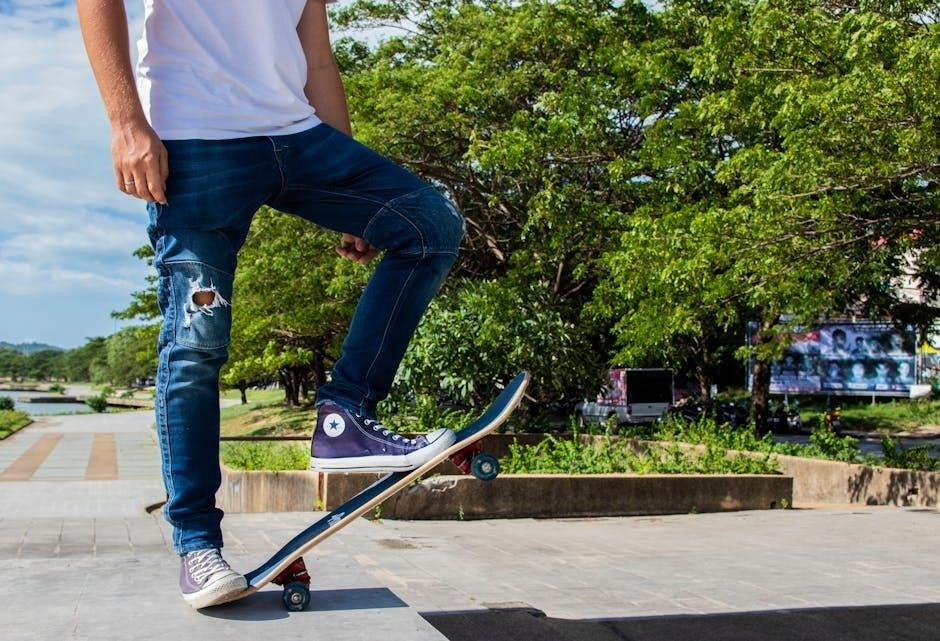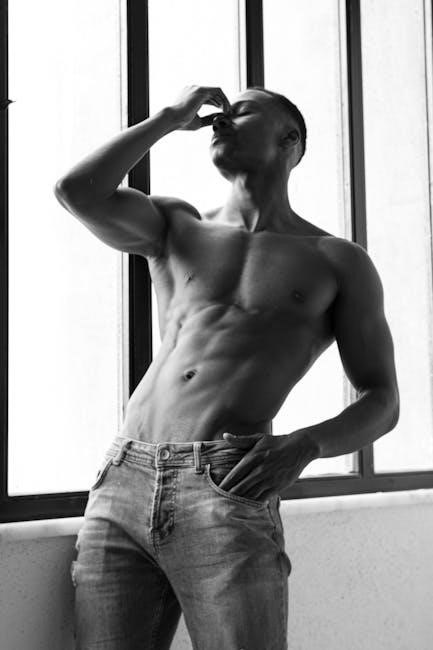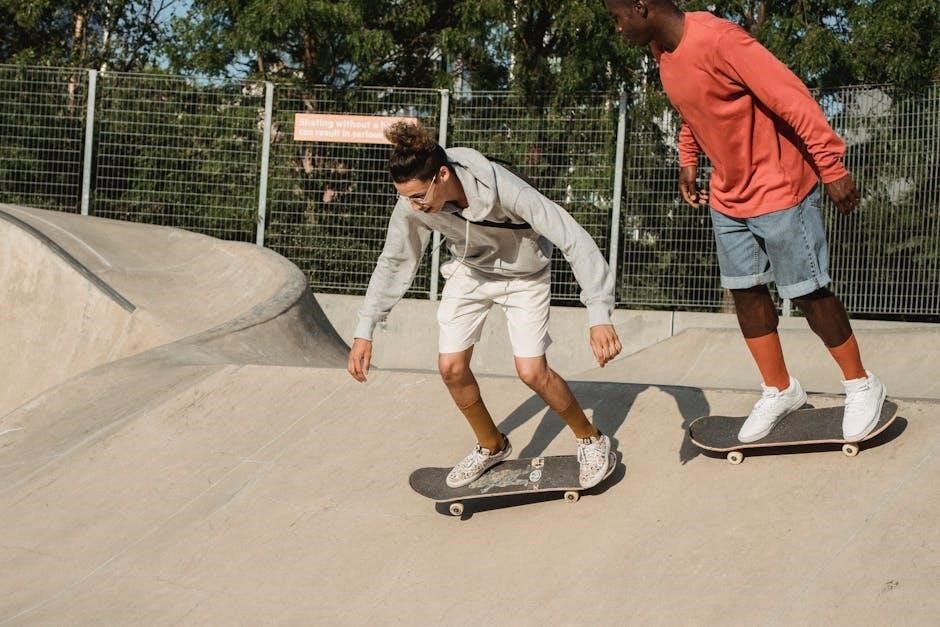How Jeans Should Fit: A Men’s Fit Guide
A well-fitting pair of jeans should sit comfortably at your natural waistline, neither too tight nor too loose. They should hug your hips and thighs without restricting movement, while the legs should drape smoothly from knee to calf. The perfect fit balances comfort and style, ensuring confidence and versatility for any occasion.
Understanding Overall Fit
Understanding the overall fit of jeans is the foundation of finding the perfect pair. A well-fitting pair should feel comfortable while maintaining a flattering silhouette. Jeans should sit at your natural waistline, staying in place without a belt and avoiding any gapping or tightness. The legs should drape smoothly from the thigh to the ankle, neither too tight nor too loose. A proper fit ensures freedom of movement and avoids restrictive areas, such as the knees or hips. The key is balance—jeans should skim your body naturally, enhancing your shape without sacrificing comfort. Pay attention to how the fabric feels; it should conform to your body without stretching excessively or feeling rigid. Achieving the right overall fit sets the stage for confidence and versatility, whether dressed up or casual.
- Jeans should sit at your natural waistline.
- Legs should drape smoothly without restriction.
- Fabric should feel comfortable and flexible.
Key Features of a Great Fit

A great pair of jeans is defined by several key features that ensure both comfort and style. First, the waist should fit snugly without a belt, sitting at your natural waistline to prevent gapping or digging. The hips and thighs should feel supported but not restricted, with a smooth drape from the knee to the ankle. The inseam should hit just above the shoe, avoiding excessive bunching or dragging. The rise, whether low, medium, or high, should complement your body type and personal style. Fabric quality is also crucial—look for denim that offers the right balance of structure and stretch for your lifestyle. Additionally, the fit should allow for a full range of motion, ensuring you can move comfortably throughout the day. These elements together create a harmonious balance that makes a pair of jeans both functional and flattering.
- Waist should fit snugly without a belt.
- Hips and thighs should feel supported but not restricted.
- Inseam should hit just above the shoe.
- Fabric should offer structure and stretch.

Types of Jeans Fits for Men
From skinny to baggy, men’s jeans come in various fits to suit different styles and body types. Each fit offers unique comfort and confidence, catering to individual preferences and lifestyles.
Skinny Fit Jeans
Skinny fit jeans are designed to be tight-fitting, hugging the legs from thigh to ankle like a second skin. They are tailored to create a sleek, modern silhouette, ideal for those who prefer a fashionable and edgy look; These jeans are typically made from stretch denim, offering both style and comfort. The tight fit ensures minimal excess fabric, making them perfect for slim or athletic body types. Skinny jeans are versatile and can be dressed up or down, pairing well with fitted tops, blazers, or casual tees. However, they may not be the best choice for larger body types, as they can feel restrictive. When styling, balance the tight fit with looser-fitting tops for a more relaxed vibe. Skinny jeans are a great option for men who want to make a bold fashion statement while maintaining a polished appearance. They are a popular choice for their contemporary aesthetic and flattering fit.
Slim Fit Jeans
Slim fit jeans offer a snug yet comfortable fit, tapering slightly from the thigh to the ankle for a streamlined silhouette. Unlike skinny jeans, they provide a bit more room through the legs, making them suitable for a wider range of body types. These jeans are ideal for men who want a fashionable look without feeling restricted. Slim fit jeans are versatile and can be dressed up or down, pairing well with button-down shirts for a polished appearance or casual tees for a relaxed vibe. They strike a perfect balance between style and comfort, making them a popular choice for everyday wear. The slightly tapered design ensures a modern aesthetic while maintaining ease of movement. Whether you’re heading to the office or a weekend outing, slim fit jeans are a versatile and flattering option for most men. Their tailored fit ensures a sharp look without compromising on comfort, making them a wardrobe staple.
Straight Fit Jeans
Straight fit jeans are a classic choice, offering a timeless style that suits most body types. They feature a straight cut from the thigh to the ankle, with no tapering, creating a balanced and relaxed silhouette. These jeans are ideal for men who prefer a comfortable fit without sacrificing style. Unlike slim or skinny fits, straight fit jeans provide more room through the legs, making them a great option for those with muscular or larger builds. They are versatile and can be paired with casual or semi-formal attire, making them suitable for both everyday wear and special occasions. The straight cut also allows for ease of movement, ensuring comfort throughout the day. Additionally, straight fit jeans can be easily dressed up or down, depending on the occasion, making them a practical and stylish addition to any wardrobe.
Relaxed Fit Jeans
Relaxed fit jeans are designed for maximum comfort, offering a looser silhouette through the seat, thigh, and leg. They provide ample space, making them ideal for men with larger or more muscular builds. Unlike slim or straight fits, relaxed jeans have a more generous cut, ensuring a comfortable fit without feeling restrictive. The loose design allows for a full range of motion, making them perfect for casual, everyday wear. Relaxed fit jeans are versatile and can be styled to suit various occasions, from laid-back outings to semi-formal events. They are a great choice for those who prioritize comfort while still maintaining a stylish appearance. The relaxed fit is particularly flattering for men with broader hips or thighs, as it creates a balanced and proportionate look. With their classic appeal and practical design, relaxed fit jeans remain a popular option for men seeking both comfort and style.
Baggy Fit Jeans
Baggy fit jeans are characterized by their loose, relaxed silhouette, offering ample room through the seat, thigh, and leg. This style has seen a resurgence in popularity, particularly in 2025, as loose-fit denim becomes mainstream; Baggy jeans are designed for comfort and versatility, making them ideal for casual outings, streetwear looks, or retro-inspired outfits. They are cut significantly looser than slim or straight fits, with a noticeable drop crotch and a wider leg opening. While they provide a relaxed feel, baggy jeans should not be overly saggy; they should still maintain a balanced, stylish appearance. Pairing them with a fitted top or jacket helps create a more polished look. Accessories like belts can also help define the waistline for a more structured silhouette. Baggy jeans are perfect for men who value comfort and want to embrace a trendy, laid-back aesthetic without compromising on style.
Bootcut Fit Jeans
Bootcut fit jeans are designed with a slightly wider leg opening that flares outward just above the knee, creating a subtle bell shape. This style is intended to fit comfortably over boots, as the name suggests, making them a practical choice for men who frequently wear rugged footwear. Bootcut jeans offer a balanced fit, with a moderate amount of room through the thigh and seat, while maintaining a relaxed yet streamlined silhouette. They are versatile and can complement a variety of body types, from slim to larger builds, by creating proportion and balance. Pairing bootcut jeans with casual shirts or jackets allows for a relaxed, everyday look, while layering with a button-up shirt can elevate the style for a more polished appearance. This fit is particularly popular among those who prefer a classic, timeless design that combines comfort with a touch of rugged charm.

How to Choose the Right Fit for Your Body Type
Choosing the right fit involves matching your body type to the jeans’ style. Slim-fit jeans suit lean builds, while relaxed or baggy fits are ideal for larger frames. Consider your lifestyle and personal comfort to ensure the perfect balance between style and practicality.
Fit for Slim Body Types

For men with a slim build, the goal is to enhance their natural physique without adding bulk. Slim-fit or skinny jeans are ideal, as they create a streamlined look that complements lean legs. These styles hug the body closely, maintaining a modern and polished appearance; Straight-leg or slim-straight jeans are also excellent choices, offering a slightly relaxed fit through the thigh while tapering subtly toward the ankle for a balanced silhouette. Avoid overly loose or baggy styles, as they can overwhelm a slimmer frame. Instead, opt for jeans with a mid-to-low rise to elongate the torso and ensure a proportional fit. Pairing slim-fit jeans with tailored tops or fitted shirts will create a cohesive, stylish outfit. For versatility, consider stretch denim for added comfort and mobility, ensuring the jeans move naturally with the body. Ultimately, the fit should highlight the slim physique while offering a comfortable, confident wear. This approach ensures a flattering and contemporary look for any occasion.

Fit for Athletic Body Types
For men with an athletic build, finding the right fit is about balancing comfort and style while accommodating muscle mass. Jeans should have a slightly looser fit through the hips, thighs, and calves to allow for ease of movement. Straight-fit or relaxed-fit jeans are ideal, as they provide ample room without appearing overly baggy. These styles maintain a structured look while offering flexibility for active lifestyles. Avoid slim or skinny fits, as they may feel restrictive and emphasize muscle bulk in an unflattering way. Opt for a mid-to-high rise to ensure coverage and support, and consider stretch denim for added comfort and mobility. Bootcut or taper-fit jeans can also work well, as they balance proportions and create a balanced silhouette. Ultimately, the fit should complement the athletic physique, offering both comfort and confidence, whether for casual or semi-casual occasions. This ensures the jeans move naturally with the body while enhancing overall style and appeal.
Fit for Larger Body Types
For men with larger body types, finding the perfect fit involves prioritizing comfort, support, and a balanced silhouette. Jeans should sit comfortably at the natural waistline, providing ample room through the hips, thighs, and seat without feeling overly loose. Relaxed-fit or straight-fit jeans are excellent choices, as they offer a comfortable fit while maintaining a structured appearance. Avoid slim or skinny fits, as they can feel restrictive and may not accommodate larger frames well. Opt for high-rise options to ensure better coverage and support around the midsection. Stretch denim is highly recommended, as it provides flexibility and comfort throughout the day. Additionally, look for jeans with a slightly tapered leg to create a balanced proportion and avoid an overly baggy look. The key is to ensure the jeans drape smoothly from waist to hem, offering both comfort and confidence. This approach ensures a flattering fit that complements the body while maintaining a stylish appearance.
Additional Considerations for the Perfect Fit

Key elements like rise, inseam, and fabric play a crucial role in comfort and style. Ensure jeans sit at your natural waist, with a comfortable inseam length. Opt for stretch denim for added flexibility and a modern fit that moves with you.

Rise and Inseam
Understanding the rise and inseam is essential for achieving the perfect fit. The rise refers to the distance between the waistband and the crotch, with options including low-rise, mid-rise, and high-rise. Low-rise jeans sit below the natural waist, offering a modern, trendy look, while mid-rise jeans provide a classic fit that sits comfortably at the waist. High-rise jeans are ideal for larger body types or those seeking extra support, as they extend above the natural waistline.
The inseam, or the length of the pant from the crotch to the hem, should align with your lifestyle and footwear. Slim and straight-fit jeans often have shorter inseams, creating a streamlined appearance, while bootcut and relaxed fits may have longer inseams for a balanced look. Ensure the hem breaks slightly above your shoes for a polished finish. Pairing the right rise and inseam ensures comfort, style, and a flattering silhouette tailored to your body type and personal preference.
Fabric and Stretch

Fabric and stretch play a crucial role in determining the comfort and fit of your jeans. Traditional jeans are made from 100% cotton, offering durability and a classic feel, but modern designs often incorporate stretch fabrics like elastane or spandex for added flexibility. Slim-fit and skinny jeans typically feature a higher percentage of stretch to hug the body closely, while straight and relaxed fits may have less stretch for a looser silhouette.
The right fabric choice depends on your lifestyle and preferences; Stretch denim provides ease of movement, making it ideal for athletic body types or active lifestyles. For those prioritizing comfort, jeans with a slight stretch can enhance wearability without sacrificing style. Conversely, pure cotton jeans offer a timeless look and feel, perfect for casual or formal settings. Balancing fabric weight and stretch ensures your jeans are both comfortable and flattering, catering to your unique needs and body type.
Waist and Hip Fit

A proper waist and hip fit is essential for both comfort and style. Jeans should sit at your natural waistline, resting comfortably without the need for a belt. They should neither sag below your hips nor dig uncomfortably into your skin. The waistband should feel snug but not restrictive, ensuring a secure fit throughout the day.
The hips and thighs should also be considered. For slim and athletic body types, a tailored fit through the hips and thighs creates a streamlined look. For larger body types, a slightly roomier fit through this area can enhance comfort and balance proportions. Avoid jeans that are overly tight, as they can restrict movement, or too loose, as they may appear ill-fitting. The ideal waist and hip fit strikes a balance, providing support and confidence while allowing for a full range of motion. This ensures your jeans look and feel great, regardless of your body type or activity level.
Real-World Fit Tips
When shopping for jeans, try them on in the afternoon, as this is when your body is at its largest due to natural swelling. Ensure the waistband sits comfortably at your natural waistline without digging in. If you prefer a belt, the jeans should stay securely in place without excessive gaping. For a polished look, pair slim-fit jeans with tailored tops, while looser fits can be dressed down with casual tees. Consider the fabric—stretch denim offers flexibility for active lifestyles, while rigid denim provides a classic feel. Avoid overly baggy jeans if you’re shorter, as they can overwhelm your frame. Finally, don’t overlook alterations; minor tweaks can transform an almost-perfect pair into your go-to jeans. These practical tips ensure your jeans not only fit well but also enhance your overall style and comfort in everyday wear.